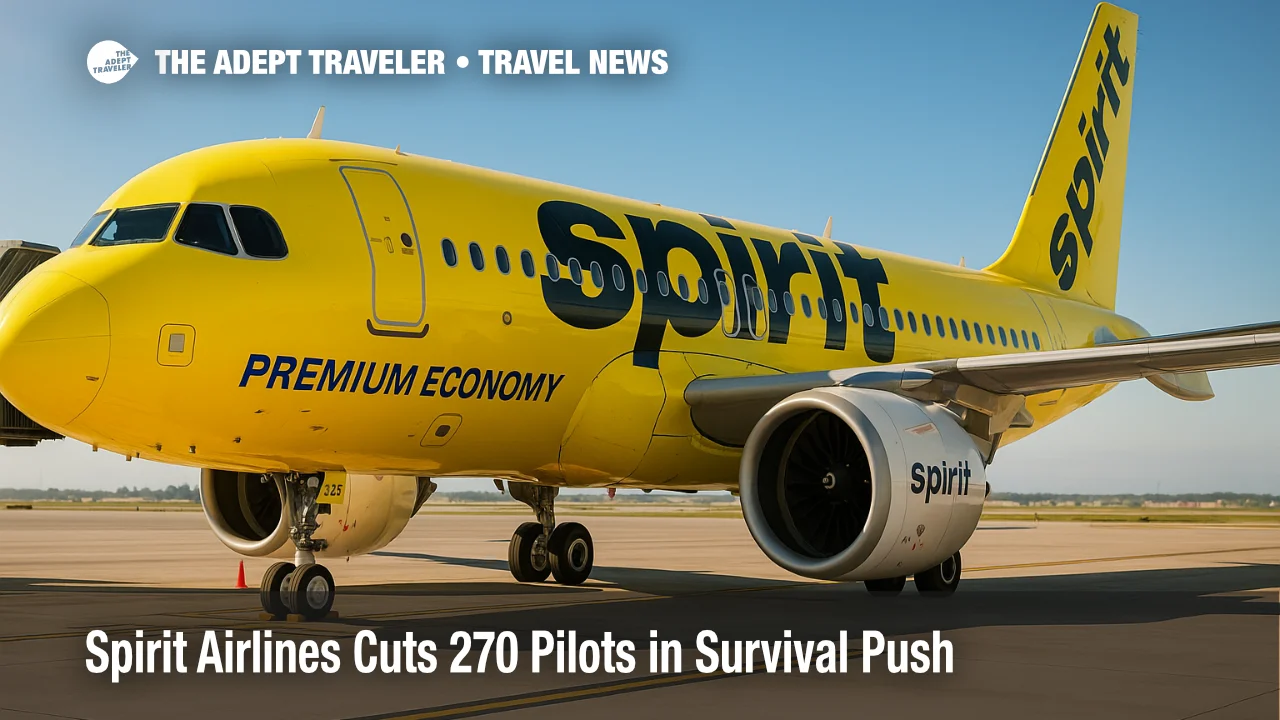Spirit Airlines Cuts 270 Pilots in Survival Push

Spirit Airlines is paring back its flight crew ranks and shrinking its schedule after a bruising 18 months that saw a blocked merger, a bankruptcy, and a radical rebrand. The carrier will demote 140 captains on October 1 and furlough 270 pilots on November 1 as it tries to steady its finances and pivot from ultra-low-cost to premium-leaning service. Executives say the move is essential to "operate as efficiently as possible" and return to profitability. Labor unions counter that repeated cuts risk hollowing out the airline's future. The downsizing raises fresh questions about Spirit's long-term viability even as it rolls out extra-legroom seats and loyalty perks.
Key Points
- Why it matters: The pilot cuts expose the fragile state of Spirit Airlines downsizing efforts.
- Furloughs: 270 pilots off payroll November 1; 140 captains demoted October 1.
- Cause: Smaller flying schedule after Chapter 11 exit and failed JetBlue merger.
- Strategy shift: Adding 32-inch-pitch Premium Economy seats and bundled perks.
- Industry context: Low-cost peers facing higher engine, labor, and fuel costs.
- Labor response: ALPA pursuing voluntary measures to curb job losses.
Snapshot
Spirit Airlines downsizing comes four months after it emerged from bankruptcy protection with $1.1 billion in fresh equity and converted debt. Management now seeks higher yields by courting travelers willing to pay for comfort, a stark departure from its no-frills past. New Premium Economy rows debuted in June and will blanket most of the 195-jet fleet by July 2026. Meanwhile, a trimmed network-down about 12 percent from last summer-forces a matching crew reduction. Analysts say the carrier must lift revenue per passenger by double digits to cover heavier debt and upgrade costs while competing against legacy airlines' basic-economy fares.
Background
Trouble snowballed after a federal judge blocked JetBlue's $3.8 billion takeover in January 2024, scuttling Spirit's quickest path to scale. Mounting losses, RTX Pratt & Whitney engine groundings, and rising borrowing costs pushed the company into Chapter 11 that November. It exited court protection in March 2025 after lenders swapped $795 million in debt for equity and injected another $350 million. A revamped board soon pledged a pivot toward "premium value," with new fare bundles-First, Premium Economy, and Value-replacing the old bare-bones model. The leadership shake-up continued in April when long-time CEO Ted Christie stepped down, underscoring the airline's volatile transition.
Latest Developments
Pilot Furlough Timeline
Union notices confirm demotions on October 1 and furloughs on November 1, marking Spirit's third wave of crew cuts since September 2024. ALPA estimates the furlough list equates to nearly seven percent of the pilot group, eroding seniority and delaying captain upgrades for years. The union is negotiating voluntary leaves and reduced-time programs to soften the blow, but warns operational resilience could suffer during peak travel periods.
Premium Seating Roll-Out
Spirit's extra-legroom seats-seven rows per jet at 32-inch pitch-went on sale May 15 for travel starting July 9. Each seat bundle includes a carry-on, reserved bin space, snacks, and no change fees, positioning Spirit closer to JetBlue's 'Even More Space' product. Installation crews reconfigured more than 100 aircraft in three weeks, and management touts early bookings as "ahead of expectations."
Network Retrenchment
The carrier is cutting unprofitable routes and frequencies, especially in competitive leisure markets. Domestic capacity for Q4 2025 is forecast nine percent below 2024 levels. Spirit will, however, maintain strategic growth such as its new Fort Lauderdale-Key West hop-covered in our recent report on Spirit's intra-Florida expansion.
Analysis
Spirit Airlines downsizing is the clearest sign yet that the post-bankruptcy reboot is far from a smooth climb-out. Shifting from an ultra-low-cost carrier to a hybrid premium model demands capital for cabin retrofits, marketing, and training-expenses that clash with the need to deleverage rapidly. Pilot furloughs reduce near-term payroll but can create costly retraining bottlenecks when growth resumes, potentially handing market share to rivals. Moreover, Spirit's reputation was built on rock-bottom fares; convincing cost-sensitive travelers to pay for comfort while luring higher-yield customers accustomed to full-service amenities is a delicate balancing act. The blocked JetBlue merger left Spirit without a partner's network breadth or loyalty base, and Frontier's lower bid in January underscores limited suitors. Until revenue trends validate the premium shift, creditors may pressure further asset sales or route pruning. If the airline fails to stabilize by summer 2026, industry analysts believe liquidation or another merger attempt could resurface.
Final Thoughts
The furlough notices do not spell certain doom, but they underscore the razor-thin margin for error as Spirit Airlines downsizing accelerates. Success hinges on filling pricier Premium Economy seats, containing costs, and restoring traveler confidence-tasks made harder by a smaller workforce and fierce low-fare competition. Travelers will watch fares and service levels closely; investors will track cash burn and debt covenants. The next 12 months will reveal whether Spirit's premium pivot is a lifeline or merely a holding pattern on the road to consolidation. For now, the question remains open: Is this the end for Spirit Airlines downsizing?
Sources
- Spirit Airlines to furlough 270 pilots, demote 140 more on downsized schedule - Reuters
- Spirit Airlines completes financial restructuring, exits Chapter 11 - Reuters
- US judge blocks JetBlue from acquiring Spirit Airlines - Reuters
- Spirit Airlines Unveils Next Major Guest Experience Enhancements - Spirit Investor Relations
